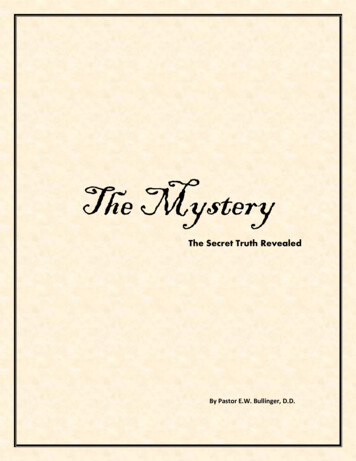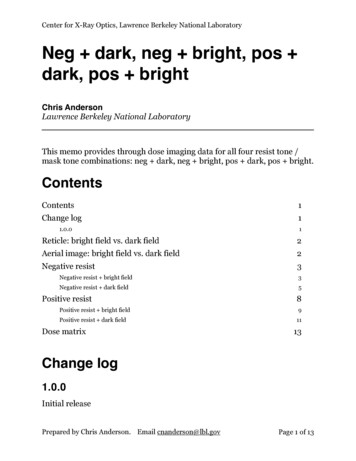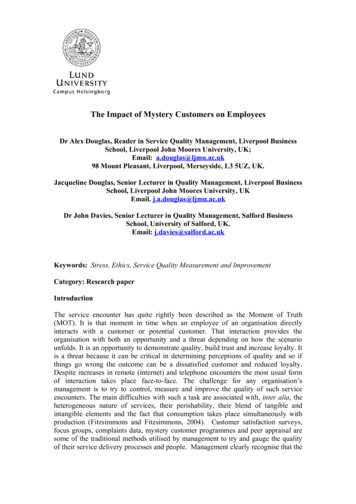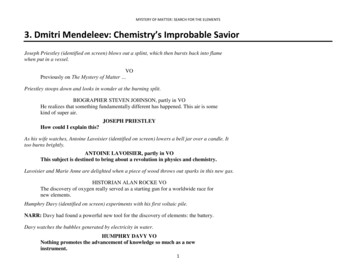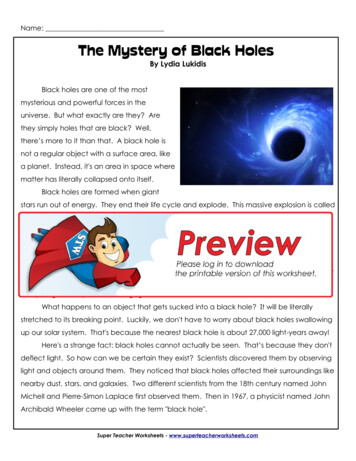
Transcription
Name:The Mystery of Black HolesBy Lydia LukidisBlack holes are one of the mostmysterious and powerful forces in theuniverse. But what exactly are they? Arethey simply holes that are black? Well,there’s more to it than that. A black hole isnot a regular object with a surface area, likea planet. Instead, it's an area in space wherematter has literally collapsed onto itself.Black holes are formed when giantstars run out of energy. They end their life cycle and explode. This massive explosion is calleda supernova. If the star has enough mass, it will collapse onto itself into a super small size.Imagine an enormous mass squeezed into a tiny space. That space would becomecompact and dense.This causes the gravitational pull to be extremely strong. It will gobble up and absorbanything in its way, even gigantic stars. Nothing can move fast enough to escape its gravity.Not even light, the fastest thing in the universe! Black holes will gobble up anything andeverything in their path, including light.What happens to an object that gets sucked into a black hole? It will be literallystretched to its breaking point. Luckily, we don't have to worry about black holes swallowingup our solar system. That's because the nearest black hole is about 27,000 light-years away!Here's a strange fact: black holes cannot actually be seen. That’s because they don'tdeflect light. So how can we be certain they exist? Scientists discovered them by observinglight and objects around them. They noticed that black holes affected their surroundings likenearby dust, stars, and galaxies. Two different scientists from the 18th century named JohnMichell and Pierre-Simon Laplace first observed them. Then in 1967, a physicist named JohnArchibald Wheeler came up with the term "black hole".Super Teacher Worksheets - www.superteacherworksheets.com
Black holes come in different sizes. Some are about the mass of one star. These arecalled “stellar” black holes. Others can grow and become huge. They may continue toabsorb light, mass, and even stars around them. These are called “super-massive blackholes.” They can be one million times more massive than our sun. Many scientists believethese super-massive black holes often exist right at the center of galaxies. In fact, we haveone right in the middle of our very own Milky Way.Strange things seem to happen around black holes. For example, the intense gravityaffects time. It behaves in strange ways. Imagine if an astronaut could investigate a blackhole somewhere in the universe. When he leaves his spacecraft to examine the black holeup close, the hands on his watch would tick at a normal speed. But if anyone aboard thespacecraft observes the astronaut’s watch from far away, the hands would slow down asthe astronaut got closer to the black hole. And when the astronaut came back to thespaceship after an hour, years would have gone by for those aboard the spacecraft!Perhaps someday, we might be able to use black holes to time travel into the future.An astronaut could take a short trip near a black hole. Then they could return to Earth aftera few decades or even centuries have passed. Imagine being gone for a few weeks, andthen seeing what life on Earth would be like in 200 years? Now that would be the trip of alifetime!About the AuthorLydia Lukidis is a published children's author with a multi-disciplinarybackground that spans the fields of literature, theater, and puppetry.Lydia's picture book, Gerbs in the House: The Dilly Dally BedtimeRoutine, is now available. Find out if Mocha will ever get his silly son tosleep!Lukidis, Lydia. Gerbs in the House: The Dilly Dally Bedtime RoutineISBN: 978-0-9917402-7-7Super Teacher Worksheets - www.superteacherworksheets.com
Name:The Mystery of Black HolesBy Lydia Lukidis1.Based on the information in the article,what is a black hole?2.Who first discovered the existence of black holes?3.Why are black holes dangerous?4.If black holes can't be seen, how do scientists know they're actually there?5.Are all black holes the same size? Explain.6.How do black holes affect time?Super Teacher Worksheets - www.superteacherworksheets.com
Name:The Mystery of Black HolesBy Lydia LukidisMatch each vocabulary word from the article with the correctdefinition.1. universea.a person who istrained to travel in a spacecraft2. matterb.a tightly compact substance3. supernovac.all matter and space in existence4. astronautd.a force that pulls an object toward thecenter of a planet or other body havingmass5. deflecte.a large ball of burning gas in outer space6. densef.a physical substance that occupies space7. Milky Wayg.a celestial body that orbits around a star8. gravityh.cause something to change direction9. planeti.the galaxy that contains our solar system10. starj.the explosion of a starSuper Teacher Worksheets - www.superteacherworksheets.com
Name:The Mystery of Black HolesBy Lydia LukidisIn the article, “The Mystery of Black Holes,” you learned what theterm “black hole” means and several reasons why scientistsconsider them so mysterious. In fact, black holes have been thesubject of many science fiction books and films over the years.In some of these fictional tales, black holes have been used asmethods of time travel, or portals into another universe.On the lines below, explain whether you think black holes could be used for time travel or aswindows to another universe. Use information from the article to support your claim.Super Teacher Worksheets - www.superteacherworksheets.com
ANSWER KEYThe Mystery of Black HolesBy Lydia Lukidis1.Based on the information in the article,what is a black hole?A black hole is an area in space where matter has collapsed in on itself.2.Who first discovered the existence of black holes?John Michell and Pierre-Simon Laplace, 18th century scientists, first discovered them.3.Why are black holes dangerous?Black holes pull in anything that gets too close and stretch things to their breakingpoint.4.If black holes can't be seen, how do scientists know they're actually there?Black holes affect light, time, and other celestial objects around them in strange ways.5.Are all black holes the same size? Explain.No. Some black holes are the size of a single star. These are called stellar black holes.Others are the size of a million stars the size of our sun, or larger. These are calledsuper-massive black holes.6.How do black holes affect time?Time slows down the closer an object gets to a black hole.Super Teacher Worksheets - www.superteacherworksheets.com
ANSWER KEYThe Mystery of Black HolesBy Lydia LukidisMatch each vocabulary word from the article with the correctdefinition.c1. universea.a person who istrained to travel in a spacecraftf2. matterb.a tightly compact substancej3. supernovac.all matter and space in existencea4. astronautd.a force that pulls an object toward thecenter of a planet or other body havingmassh5. deflecte.a large ball of burning gas in outer spaceb6. densef.a physical substance that occupies spacei7. Milky Wayg.a celestial body that orbits around a stard8. gravityh.cause something to change directiong9. planeti.the galaxy that contains our solar systeme10. starj.the explosion of a starSuper Teacher Worksheets - www.superteacherworksheets.comLD
The Mystery of Black Holes By Lydia Lukidis In the article, “The Mystery of Black Holes,” you learned what the term “black hole” means and several reasons why scientists consider them so my

